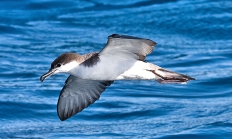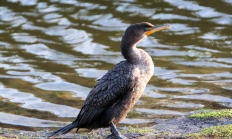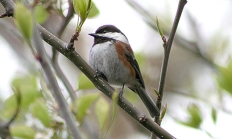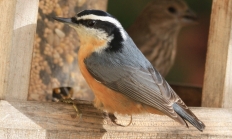Search myodfw.com
Few seabirds have been labeled "stunning;" but with their graceful flight, boldly patterned upperparts, and brilliant white underparts, these birds truly are one of the most beautiful in Oregon waters. They have a black cap, wings angled forward, long body and tail, and a unique dark 'M' pattern against light gray back and wings. Often seen in small groups mixed among other more abundant shearwaters, they sometimes form pure flocks all flying in gracefully synchronized flight. While regular in Oregon in late fall, they are still uncommon enough to excite observers when encountered at sea. Photo by Tony Morris, Flickr

This seabird, the most abundant in Oregon, has recently suffered severe declines or significant population shift in the eastern North Pacific. Similar in shape to thin, long-winged gulls, sooty shearwaters are dark sooty gray with limited amounts of white on the underwing coverts. They glide on wind currents along wave troughs on stiff wings. Gregarious, they form huge loose flocks in migration, often passing for hours within site of land-based observers. In Oregon, it is an abundant summer visitor and transient offshore on the inner shelf and is most numerous three to six miles offshore. Hear the call of the

These very abundant seabirds are uncommon off Oregon in winter. Their arrival coincides with some of the Pacific Northwest's stormiest weather. Complicating detection difficulties is their identification; they look very much like the abundant sooty shearwaters - all dark, but slightly smaller with shorter bills and tails. Studied on their Tasmanian breeding grounds continuously for over 45 years, once they leave for the open ocean little is known about them. Popularly know as "muttonbirds," they have been harvested as food for centuries on their southern seas breeding islands. Even today, up to 300,000 chicks are harvested in Tasmania each year

In Oregon, fork-tailed storm-petrels breed in numbers that are only a tiny fraction of those of Leach's storm petrels. This is the larger of the two storm-petrels breeding in Oregon and is gray in color. These birds leave and return to breeding colonies only at night, when they are best detected by their distinct raspy call. At sea, they are distinguished by quick, buoyant flight with short glides interspersed with wing fluttering to maintain their position at a food source. Fewer than 20 nests have been found in Oregon, all located in the same habitat as colonies of Leach's storm

Of Oregon's breeding seabirds, Leach's storm-petrel is the smallest, most pelagic, and flies the farthest offshore of any of Oregon's breeding seabirds to feed. It spends the non-breeding season in the subtropical and equatorial Pacific. It is the second most abundant breeding seabird in Oregon, and is rarely seen from land or close to shore. It comes to its breeding islands, where it nests in burrows, only under the cover of darkness. Its plumage is black and Oregon populations have a distinct white rump. Leach's storm-petrels are long lived birds characterized by long-term pair bonds and may breed yearly for

Oregon has two species of pelicans, American white and the Brown pelican, and three species of cormorants. All are fish-eating water birds with four toes joined by webbing. Depending on the species, pelicans and cormorants inhabit the Oregon coast, rivers or interior waterbodies.

Commonly found along beaches and about estuaries, this large, ponderous bird is a conspicuous member of the summer coastal community, easily recognized by its large size, massive bill, and brownish plumage. Highly gregarious, it often forms large flocks; regularly observed foraging over the ocean just offshore. Brown pelicans often join mixed flocks of birds attracted to schools of small fish. They are common spring, summer, and fall visitors along the Oregon coast. Brown pelicans are an Oregon Conservation Strategy Species in the Nearshore ecoregion. Hear the call of the brown pelican Photo by Michael Lazott

Brandt's cormorants nest colonially on offshore islands and mainland cliffs and are the most common of the cormorants on the Oregon coast in summer. In the breeding season, males are easily distinguished by their intense blue gulag pouches, displayed with a skyward pointing of the bill. They also have wispy white plumes along the side of their head and on their back, which show well against the solid black of the rest of their plumage. In bright light they have a green iridescence. During all seasons they can be distinguished from the two other Oregon species by buff-colored feathers that

Adaptable and opportunistic, the double-crested is the most abundant and widespread of the three cormorant species found in Oregon, occurring inland and on the coast. Adults have deep, coppery feathers, bordered in black, that glisten with a green iridescent and offset a rich orange throat atop a long curved neck. The bird earns its name from plumes, ranging from white to black, that crown either side of the head during the breeding season. The double-crested cormorant is a common breeder in spring and summer at bays and estuaries, and on islands and cliffs along the coast and lower Columbia River

Seemingly misnamed, pelagic cormorants are rarely seen far from land. During the breeding season the distinct white flank patches contrast markedly with their black plumage. In bright light the slender neck has a purple iridescent sheen, and the back shines green accenting white filoplumes. They nest in loose colonies on ledges on vertical cliffs on rocky islands and headlands. It is common year-round along the entire coast and is not found away from salt water. Hear the call of the pelagic cormorant Photo by ©Greg Gilson

Bitterns, herons, and egrets are all long-legged wading birds with long necks and pointed bills for spearing fish or other prey.

Fun little birds to watch, chickadees and nuthatches are common in Oregon. With short, strong bills, they feed on insects and seeds and are often seen in groups.

An acrobatic flier with a dashing white eye-stripe, the Mountain chickadee is a common year-round resident of Oregon's high-elevation coniferous and mixed forests. This species is distinguished from other North American chickadees by its white eyebrow, gray flanks, and gray undertail coverts and by its drawling, hoarse-sounding chick-a-dee-dee-de call. It is resident in all types of forests from two to 10 miles west of the Cascades summit and east, in the Blue, Siskiyou, Wallowa and Warner mountains and on Hart, Steens and other isolated mountains east of the Cascades. Hear the song of the Mountain chickadee Photo by Simon Wray

Chestnut-backed chickadees are one of the most common species of bird in conifer forests of western Oregon. They are distinguished from other chickadees by their chestnut-colored back, lack of an eye-line, and their wheezy song. Like other chickadees, they are frequently observed performing acrobatic maneuvers such as hanging from branch tips while foraging high in the canopy. They also frequent bird feeders for suet and sunflower seeds, and will nest in boxes if they are placed near groves of conifers. Hear the call of the Chestnut-backed chickadee Photo by Kathy Munsel, ODFW

This species reaches the northern limit of its range in southwest Oregon. Oak and Juniper titmice were formerly in the same species as the Plain titmouse but were recognized as a separate species in 1997. The drab, gray color with distinct crest and chickadee-like calls and behavior characterizes these species. Plumage of sexes is identical. The Oak titmouse is a friendly, high-spirited, and melodious bird of oak-dominated habitats of interior valleys and lowlands. It is a common resident in oak woodlands of the interior Rogue Valley, and a rare but permanent resident in Illinois Valley. Hear the call and song

The Juniper titmouse presents the demeanor of a miniature jay with its crest jutted proudly upright. It is a pale gray bird above and underneath, with little or no brown coloration. Songs and calls are useful in locating hidden titmice. The Juniper titmouse occurs in pinyon pine-juniper woodlands in the bulk of its range. This bird is a cavity nester. The nest is often placed in a crevice of a twisted trunk of large, older junipers. It primarily forages in junipers and juniper seed are important in the winter diet. An Oregon Conservation Strategy Species in the Northern Basin and

A group of twittering, tiny gray birds streaming through bushes and trees and across openings surely are Bushtits. Females' eyes are pale, males' dark. They are highly gregarious except when nesting. The intricately made sock-like nest is unusually large for the size of the bird. Bushtits show a distinct indifference to humans and regularly nest within residential neighborhoods and establish foraging routs throughout many cities. They regularly take suet at bird feeding stations and visit backyard birdbaths. The Bushtit is a fairly common resident throughout Oregon except in Umatilla, Union, and Wallowa counties and at higher elevations of mountain ranges

The Red-breasted nuthatch is a happy, jolly little bird, quick and agile in its motions and seemingly always in a hurry to scramble over the branches. It is distinguished from other nuthatches by white eyebrows, black eyelines and cap, reddish breast, and nasal yank yank song. Although males have a blacker cap and redder breast than females, distinguishing sexes in the field is difficult. During winter, is can be observed foraging in mixed-species flocks with Chickadees, Brown creepers, Kinglets, Townsend's carblers, and Dark-eyed junkos. The Red-breasted nuthatch breeds and winters throughout Oregon where conifer or mixed conifer-hardwood forests are present

Among the largest of the world's nuthatches, White-breasted nuthatches also are noteworthy for an extensive repertoire of unusual behaviors and habits. Unlike most other North American passerines, White-breasted nuthatches maintain close pair bonds over most of the year. In spring, they cement their pair bond by exhibiting a variety of courtship displays. Elaborate display rituals also are used in antagonistic territorial interactions, and distraction displays are used to deter predators. The White-breasted nuthatch is common in western Oregon lowlands. It is most abundant in southwestern interior valleys, with specimens from Salem to Jackson County. It occurs in oak and mixed

A constant chatter of high-pitched staccato tidi tidi tidi or tideet tideet calls coming from the canopy of ponderosa pine forests east of the Cascade Range is a sure sign of the presence of this tiny, highly active, social nuthatch. Measuring only 3.75-4 inches long, this stubby mite is the smallest and plainest of the three western U.S. nuthatches. This is a tree-bark clinger that has a woodpecker-like bill for probing bark, opening seeds, and cavity excavation. The Pygmy nuthatch forages all the tree surfaces from the trunks to the outer- and top-most needles and cones. The Pygmy nuthatch is

